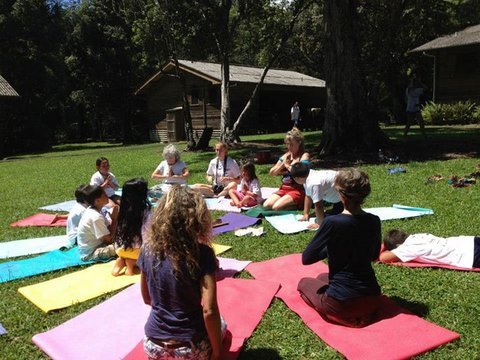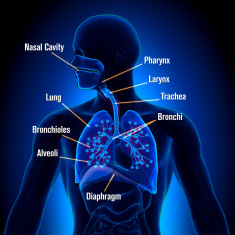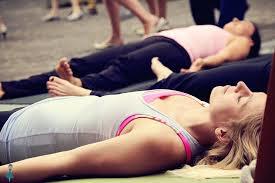Yoga for a Mindful Life: Breathe easy with pranayama
It’s a life-or-death matter: Just a few minutes of oxygen deprivation can destroy the brain’s ability to function forever — but few of us realize that how we breathe affects every moment of our lives.
So take a breather. Yoga breathing, or pranayama, meaning “life force extension,” is the mysterious fourth limb of yoga that comes after the third limb, asana, in Patanjali’s Yoga Sutras (Aphorisms), but there’s nothing obscure about the simple act of breathing.
Taking our first breath at birth and our last breath at death as two bookends, we will likely breathe in our lifetime more than 550 million breath cycles. We breathe 15 to 18 times per minute, or about 20,000 breaths per day. Our 37.2 trillion cells need continual oxygen to burn nutrient fuel and sustain life energy. Even a tiny improvement in breathing can make a huge difference.
The benefits of becoming more conscious of your breathing are profound: more energy and focus, deeper relaxation, glimpses of the inner world, peace of mind and even life extension. Each breath is a new chance to let more life flow through you, to let go of resistance and cultivate compassion for yourself and others.
Dozens of studies published by Harvard Medical School show that yoga breathing can relieve depression, anxiety and trauma.
So, here are our basic breath exercises guaranteed to give you a natural yoga buzz:
1. Nose Breath
Good breathing starts with awareness. Every time you remember, pay attention to how you are breathing. No judging. Just notice. Close the mouth and breathe in through the nose, where the inhaled air is humidified, warmed and cleansed of bacteria and other particles before reaching the airways and lungs. Exhaling through the nose rewarms and remoistens it while the trapped particles are blown out.
When we breathe through the mouth, we take in unfiltered air that is cold, dry and full of particles, making the airways narrowed, irritated and inflamed, which is why it is better to inhale and exhale through the nose. The mouth is for eating, speaking and kissing. The nose is for breathing.
2. Ocean Breath
Often called dirgha pranayama, or the complete breath, Ocean Breath invites us to exercise every air passageway by filling the lungs completely. Sit with your spine erect or lie down on your back. Begin taking long, slow and deep breaths through the nostrils. Let the exhale flow out naturally and passively. Close your eyes and focus inside. Notice how this creates a sound like ocean waves.
Ocean Breath reaches deeply into the lower part of our lungs, using the diaphragm — our most important breathing muscle, a dome-shaped muscle, like an umbrella. On a slow inhale, feel the diaphragm moving downward to massage the abdominal organs and touch the side ribs to feel the chest expansion. Bring air deeply into the full bronchial pattern — the shape of an upside-down tree — from the trachea to the alveoli.
Feel the exhale from the top of the lungs, moving toward emptiness at the bottom of the lungs. Contract the abdominal muscles to squeeze out all of the residual air. Pause briefly before beginning the next conscious inhale. This keeps the chest and lungs healthy, flexible and relaxed.
Especially in the autumn when the air is dry, Ocean Breath can help clear up vog-related problems like cough, cold and congested sinuses, bronchial and nasal issues. It increases overall energy, improves digestion and assists elimination.
After breathing like this for a while, it starts to feel natural. You can do Ocean Breath during an asana practice, before meditation, to help you sleep, or anytime you feel like it.
Kids as well as adults love these next two yoga breaths:
3. Bumblebee Breath
Use your fingertips to lightly cover your closed eyelids. With your thumbs, close your ears. Inhale deeply through the nose and on the exhale, let out a low humming sound. With the eyes and ears closed, lengthen the hum so it reverberates in your head and sounds like a buzzing bee. Repeat three, four, or more times.
As you do the Bumblebee Breath, bring your inner gaze to the third eye, the point between your eyebrows. The Bumblebee Breath calms the mind and inspires new creative ideas.
Next time you are feeling overstimulated or uninspired, be like a bumblebee and buzz.
4. Dog Breath (a.k.a. breath of fire)
You may need to wake up your inner child for this one. Breath of Fire, kapalabhati (skull shining) helps increase concentration, massages the internal organs of head and chest and increases lung capacity. It exercises your quality of attention while it soothes and clears the diaphragm and respiratory organs
For Dog Breath, pant like a dog, first through the open mouth. Then, close your mouth and continue the panting breath through the nose. Do two sets of 30 seconds each, pausing between the sets and taking deep breaths. This technique brings oxygen to the brain and helps you wake up and feel more alert.
Marya Mann is writer and yoga teacher. Contact her at marya.mann@gmail.com.






